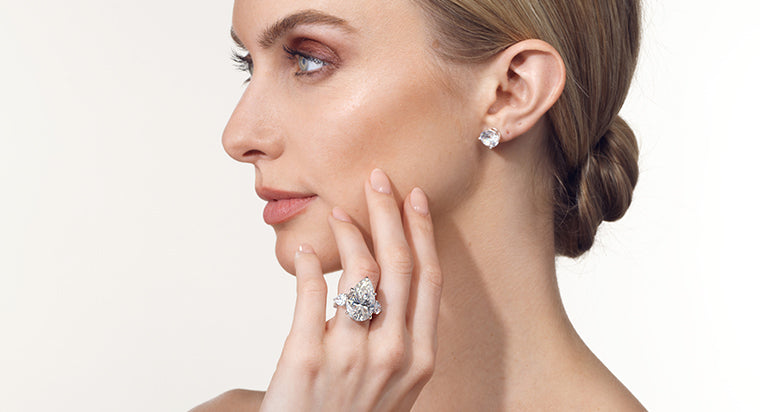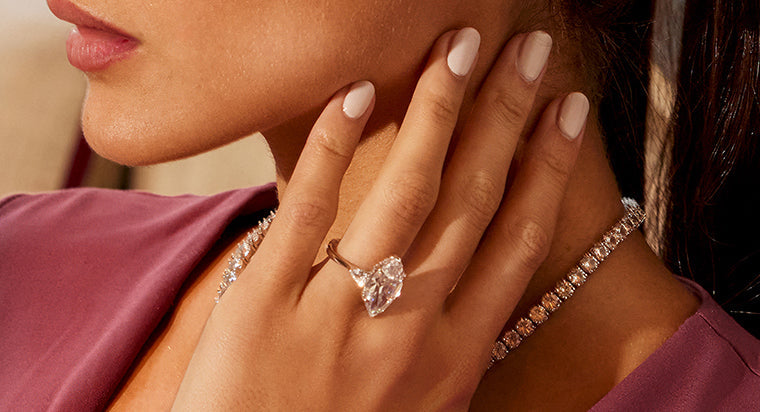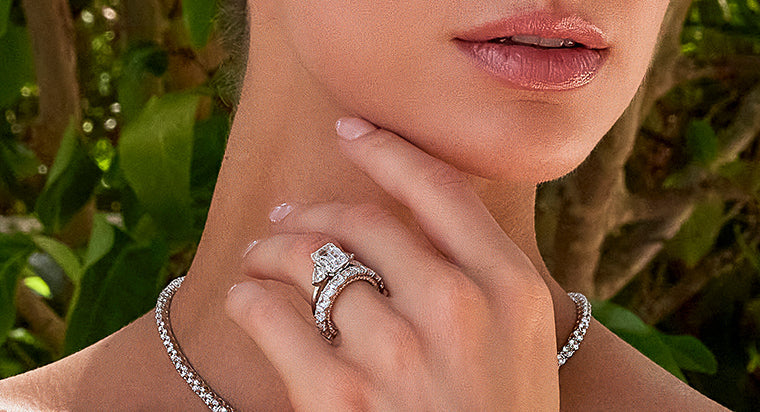Anniversary Band Buying Guide

Every relationship milestone is a special celebration deserving of a memorable gift. If your anniversary is coming up, then a stunning anniversary band for your partner is an ideal gift.
TABLE OF CONTENTS
If you’re shopping for anniversary bands, we’ve gathered information so you can make an informed decision and gift a beautiful ring that wows.
Picking the Perfect Diamonds
As you consider the perfect anniversary band you want for your partner, you’ll want to consider what diamonds you want. There are so many stunning options! Keep reading to learn about diamond options so you can ensure you get the ring you want.
The first decision to make is whether you want lab-made or earth-mined diamonds. Lab grown diamonds have the same chemical composition, optical properties, and physical features as natural diamonds. Keep in mind that this decision impacts the price of your anniversary band. Both types of glittering gemstones have pros:
Price: Lab grown diamonds are more affordable in comparison to natural diamonds. In general, you will pay 30% less on a lab diamond than you would on an earth-mined diamond. This price difference is because mined diamonds go through a longer supply chain and are more rare, and they require more costly resources in terms of setting up the mining.
Durability: Diamonds (natural and lab made) are the hardest material on earth—a 10 on the Mohs hardness scale. They are equal in terms of longevity.
Ethically sourced and conflict free: You can pinpoint the origin of lab grown diamonds and lab diamonds are widely available. Some natural diamonds have origin information as well. With Clarity only works with reputable diamond cutters who can ensure they are working with conflict-free and ethically sourced diamonds.
Environmentally friendly: For lab diamonds, the environmental impact is reduced, mined diamonds can have impact upon environments as is the same with mining any materials out of the earth.
Next, you’ll want to decide the cut (shape) for your diamonds. Try to gather what shapes your partner prefers–everyone has their own likes and dislikes, so you’ll want to use this info to help you decide.
Here are some popular diamond shapes to consider:
- Round Brilliant: Round Brilliant: A round brilliant diamond is perfect for someone with a classic sense of style. It’s a popular diamond cut and has plenty of sparkle because of their 58 facets.
- Princess Cut: Princess Cut: A square-shaped princess cut has a variety of acceptable facets, but also has tons of sparkle. It’s a great cut for someone with a classic, sophisticated style.
- Emerald Cut: Emerald Cut: An emerald cut has long, parallel step cuts and clipped corners. The purpose of the clipped corners is to prevent fractures and improve its stability. The parallel lines enhance the diamond's strength and durability to protect against chips. An emerald-cut diamond works well for someone with a sophisticated, unique sense of style.
- Oval: An oval-shaped diamond is a variation of the round gemstone that offers the brilliance and fire of a round-cut gemstone in a more unique shape. This shape works well for someone who likes to be unique and stand out from the crowd.
Choosing the Design
You’ll find plenty of anniversary band options. Today the three-stone and five-stone anniversary bands continue to be popular. It’s said that the three-stones represent the past, present, and future. You can also look at how the diamonds are set. Some have prongs while others have channel set diamond bands.
Selecting the Metal
Anniversary bands come in different metals, so you’ll need to consider metal preferences as you browse for rings. The metal impacts the overall ring appearance and can affect the price.
Before we dive into the different types of metals, it’s important to note that gold’s karatage refers to the percentage of pure gold in the alloy: 18k gold contains 75% gold and 14k gold contains 58.3% gold. Jewelry often is 14k gold because the higher percentage of included alloyed metals provides more durability and resistance to wear and tear.
Platinum: As time passes, the metal does develop a patina that might make it look a little dull. This metal is a hypoallergenic option with a classic, sophisticated look. Platinum costs more than gold, so keep that in mind as you browse anniversary bands. In general, platinum jewelry contains 85 to 95 percent pure platinum.
Yellow gold: Yellow gold is the familiar, shiny metal that’s popular for jewelry. In general, 14K gold is only 58.3 percent pure gold. Generally, yellow, white and rose gold cost around the same amount. One con of yellow gold is that it will need regular polishing and cleaning.
White gold: White gold is a mixture composed of pure gold and metals, such as zinc, nickel, and copper. This combination gives white gold its strength and whiter color. A pro for this metal is that it’s more affordable than platinum. Yearly rhodium plating will keep it looking shiny and bright.
Rose gold: Rose gold is real gold, but it’s not made entirely of gold–the copper and silver helps to strengthen it and provides its warm pinkish color. The more copper used, the redder the rose gold appears. It’s a great metal if you want your ring or jewelry to really stand out.
Metal choice can affect the overall look: Talk about how the metal you choose affects the overall visual appeal of the anniversary band. Additionally, it can affect the price too. Choose something that matches her
Shopping Tips for Anniversary Bands
You have plenty of available options, but here are some helpful hints as you shop for anniversary bands.
Cohesive stack: If you plan to wear two rings on the same finger, for example your wedding ring and anniversary band, pick the same metal for the anniversary band as the wedding set to create a cohesive look.
Mixed metals: If you plan to mix metals, keep similar tones together. For example, pair rose gold with yellow gold or platinum with white gold.
Diamond type: If you’re selecting a lab-created or natural diamond, make sure it’s certified by renowned institutes such as IGI and GIA. Certified diamonds are a good way to ensure authenticity, and they also come with details about the quality.
Certified: Certified diamonds come with proof of ownership and authenticity. It’s insurance that you’re getting what you pay for, which is worth the peace of mind and having confirmation of your authentic stone.
Brand: Buy from a reputed brand that offers easy returns and exchanges if you’re dissatisfied with the product or have any issues. Research the warranty, reputation of the company, and the exchange/refund policy.
Budget and Preferences: Keep your budget and your special someone’s preferences in mind as you shop for bands. There are plenty of factors that impact the budget–metal choices, diamond type, diamond quality and design.
FAQs
How to wear an anniversary band?
If you receive an anniversary band, you can wear your wedding ring, then an engagement ring followed by the anniversary band. You can also choose to wear the anniversary band in place of the engagement ring and wedding band or have it made to fit your right hand ring finger.
How to stack an anniversary band?
Your stack depends on your current wedding set and your personal preferences. If you plan to add more anniversary bands over time, some choose to wear them above the engagement ring. Some choose to wear one above and one below the wedding band.
Which is the best metal for an anniversary band?
Metal choices depend on personal preferences and the metal sensitivity of who will be wearing the ring. White and yellow gold are popular metals for anniversary bands, but you can find rings in other metals, such as platinum if you want a hypoallergenic option.
On which anniversaries are you supposed to give an anniversary band?
There aren’t specific anniversaries in which an anniversary band is expected. Some couples choose to commemorate a milestone anniversary with a special band, such as 10, 15, 20, 25, while others give an anniversary band when it’s unexpected.









